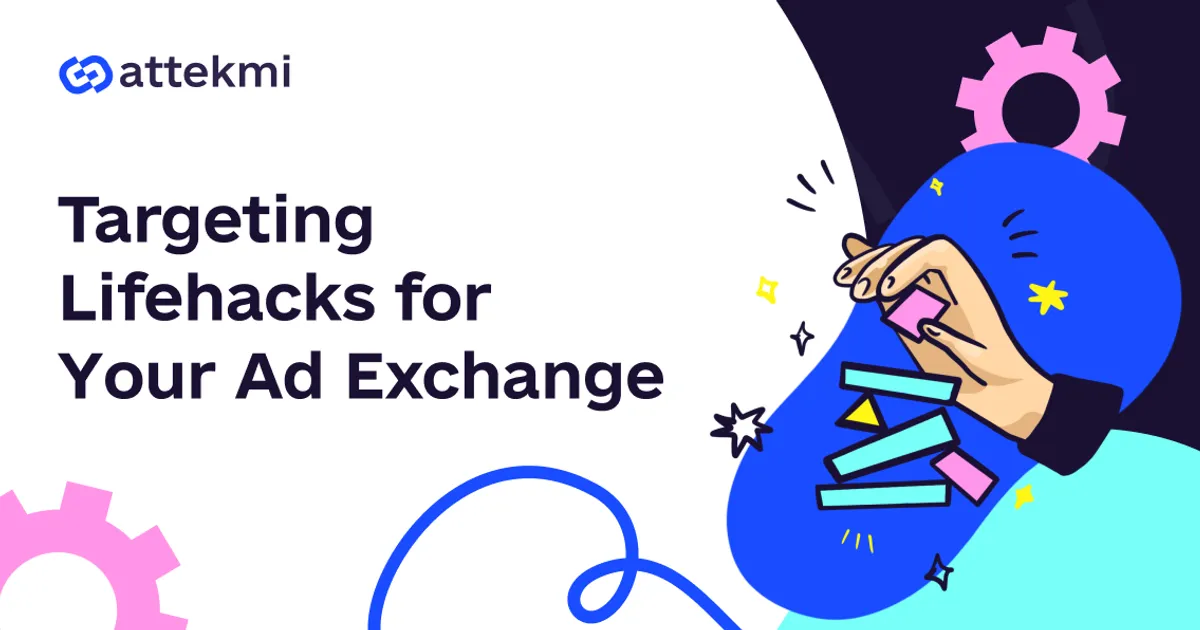In digital advertising, precision targeting plays a crucial role, even though it works differently for advertisers and ad exchange owners. However, the key aspect is still the same – to establish the right connections.
So, what is precision marketing, and why is it important? What features should an ad exchange have? What metrics to measure? What does it mean for advertisers and the owners of ad exchange solutions? In this guide, we will dive into the nuances of precision targeting, so read on to gain some actionable insights!
Key Takeaways
Precision targeting enables advertisers to deliver personalized ads to specific audience segments and helps ad exchange owners connect relevant supply and demand more effectively.
Key steps include collecting high-quality data, analyzing audience behavior or partner profiles, and continuously optimizing campaigns or exchange connections.
Important targeting parameters for ad exchanges include ad formats, traffic types, geo, ad sizes, OS, device, and player size, ensuring better campaign outcomes and revenue growth.
Advertisers track metrics like CTR, CPL, ROAS, and conversion rates, while ad exchange owners focus on trading revenue and impression volumes to measure targeting success.
Attekmi’s ad exchange solutions come pre-equipped with precision targeting features and advanced analytics, enabling faster go-to-market and higher monetization potential.
What is precision targeting in digital marketing?
For advertisers, media precision targeting is a technique involving using customer data and targeting ads toward different segments of consumers. For instance, marketers can target their audience on the basis of age, gender, location, behavior patterns, etc. This allows high personalization and relevance and ensures the effectiveness of an advertising strategy.
In terms of ad exchanges, precision targeting works differently – you need to ensure a reliable connection between supply and demand. For example, you may set up ad formats and traffic types for each so advertisers with banner ads and desktop traffic can easily reach publishers who meet these requirements.
How does precision targeting work?
Actually, whether you are an advertiser or an ad exchange owner, the basics of precision targeting are similar. Take a look at them:
Collect the data. Relevant data is a key to precision targeting, so the first step is to gather it. It would be helpful to contact your supply and demand partners to clarify any missing information, if necessary. Actually, the more you know about them, the better: what traffic types they offer or are in search of, what ad formats they support or require, etc. In turn, advertisers can use the data they already have. If there is none, it would be helpful to create a first-party data strategy by collecting first-party data by asking users to fill in website forms (in exchange for something valuable, like a whitepaper) or surveys, to take part in a rewards program, and so on.
Improve data quality. It is important to keep your database well-organized and up-to-date. Therefore, make sure that it does not include unnecessary data, duplicate data, etc. This step is the same for both advertisers and those operating ad exchange platforms – clean data is something any business needs.
Analyze the data. Thoroughly analyze the data to identify SSPs and DSPs that will fit each other perfectly. Note that your ad exchange should have advanced analytics capabilities to be able to provide detailed insights into the performance of your solution. This way, you will be able to fine-tune your strategy and maximize its efficiency. As for advertisers, they can analyze their top customers to learn more about them and build detailed customer profiles for future campaigns.
Put the data into action. Finally, use the insights to set up the connections on your ad exchange. Monitor the performance of your platform continuously to make sure that everything works as it should. As for advertisers, they need to specify targeting characteristics (like age, location, hobbies, etc.) when setting up the campaign. In the case of programmatic advertising, this is done via a demand-side platform (DSP).
Analyze the results. Even if you are absolutely sure that you set everything up correctly, it is essential to monitor the performance of your ad exchange continuously. This way, you will be able to adjust your strategy promptly. The same applies to advertisers – they need to keep an eye on their campaigns to fine-tune them (if necessary) and collect new data.
How precision targeting enhances campaign efficiency and effectiveness
Precision targeting is important for all the parties involved in programmatic advertising. Thus, marketers deliver their ads exactly to those users who are most likely to get interested and convert. Publishers ensure relevant experience for their website visitors or app users. In turn, ad exchange owners increase the media trading income and make the platform more popular among demand and supply partners. Let’s summarize the reasons why precise targeting matters.
Better understanding of the audience needs
By collecting and analyzing data for targeting, marketers, publishers, and ad exchange owners get a better understanding of their audiences and their needs. For instance, advertisers can use such insights to tailor their campaigns to the preferences of a specific audience segment, which can help drive ROI. You, as an ad exchange owner, learn more about your partners and ensure effective connections between them. As for publishers, by discovering who visits their websites (or uses their apps), they understand what they can offer to advertisers and monetize their media sources efficiently.
Increase in sales, income, and ROI
With precise targeting, advertisers can increase conversions and sales and maximize ROI. Publishers drive greater income as well since they sell their ad inventory more efficiently. Ad exchange owners increase their income as well – basically, effective targeting is the main factor impacting their media trading revenue.
Focus on important things
Addressing the right audience, as well as matching the right supply with the right demand, allows for focusing on what matters. For instance, advertisers can eliminate their spend on users who are not likely to respond and prioritize those who have a high chance of conversion. You, as an owner of an ad exchange solution, can focus on monitoring its performance and identifying new revenue opportunities.
Increased loyalty
Relevant and personalized ads allow advertisers to gain and increase their audience’s loyalty. The same applies to publishers – when their media sources deliver targeted ads to users, they receive a relevant experience, which can motivate them to come back to this specific website or app. Finally, if an ad exchange delivers ultimate performance (and precision targeting plays a crucial role in this), supply and demand partners will consider it reliable and effective.
6 strategies to power precision targeting
To identify targeting options for your ad exchange, you can start by analyzing your competitors. This would be helpful in any case since, with the collected insights in mind, you will be able to make your platform more effective and attractive for DSP and SSP partners.
However, there are several basic options to consider.
Ad formats
Integrating ad format targeting is virtually a must to match SSPs and DSPs efficiently. These can be banner, video, CTV, audio, and other ads. The more formats you add, the more deals will become available, which is good for your trading income.
Traffic type
Traffic type targeting options may include desktop, mobile web, in-app, and other settings. Your ad exchange should support multiple traffic types to ensure proper performance. Obviously, you can still focus on a specific traffic type (for instance, mobile), but a variety of options will ensure greater freedom of action for your partners, which will positively affect your revenue.
Ad sizes
If your ad exchange platform allows setting ad sizes and dimensions for your partners, it will deliver the ultimate visual experience to users. This is good for all the parties involved. While advertisers will have higher conversion rates, publishers will provide compelling ads to their website visitors or app users. As for you, your income will increase.
Player size
Video ads can be delivered to players of different sizes, starting from small ones and ending with full-screen options. Therefore, it would be useful for your ad exchange to be equipped with the player size targeting capability. This way, users will get the experience of the expected quality (which is beneficial for both marketers and publishers), while you will successfully monetize your platform.
Device OS
Since there is a variety of operating systems, your ad exchange should have the device OS targeting functionality. Thanks to it, you will be able to create even more effective connections between your supply and demand. Again, this is good for your income, while advertisers and publishers benefit from maximized performance.
Geo
Last but not least, consider adding geo-targeting capability to your ad exchange. This way, when your DSP partner requests traffic, it will receive it exactly from the requested location.
After you identify the essential targeting capabilities for your ad exchange and integrate them into your platform, test them to ensure that everything works as it should.
Note that it is also essential to monitor the performance of your ad exchange thoroughly. If something goes wrong, you will be able to react on time. As for advertisers, the most crucial recommendation for them is to analyze the data thoroughly, segment the audience, and then use these insights for precision targeting. Launching dynamic ads will help ensure greater personalization, while conducting A/B tests will make the whole strategy more data-driven.
Key metrics for measuring precision targeting success
To understand the success of precision targeting, it is essential to track a variety of metrics. However, they are different for advertisers and owners of ad exchange solutions. For instance, here are some important metrics for marketers to pay attention to:
CTR (Click-Through Rate) by audience group to understand which specific groups responded best to the campaign.
Cost per Lead (CPL) for target groups to identify the groups with the most effective budget allocation.
Interactions like website visits or content downloads to see if targeting efforts bring the desired results.
Lead-to-Opportunity Conversion Rate to see how effectively leads are converting into opportunities (a high rate usually means that targeting is set up properly).
Cost-Effectiveness to understand ROI while focusing on specific audience segments.
However, for owners of ad exchange platforms, things are a bit different. Basically, your income is the main indicator of precision targeting effectiveness. When it keeps increasing, you can rest assured that you are doing everything in the right way. Obviously, if it is decreasing, you need to pay attention to your targeting settings and update them to ensure the effective performance of your platform.
At the same time, it would be useful to keep an eye on the number of impressions served via your ad exchange solution. A high rate shows that the platform is operating efficiently, which is a sign of precision targeting. In general, the more analytical data your platform provides you with, the better. Thanks to it, you will get a more comprehensive understanding of the solution’s performance.
Precision targeting with Attekmi
Building an ad exchange from scratch and equipping it with all the essential capabilities to ensure precision targeting (and not only) is expensive and time-consuming. However, there is an alternative — you can go for one of Attekmi’s solutions. There are several ad exchange options to choose from:
AdEx Basic: an entry-level platform equipped with basic functionalities.
AdEx Plus: an enhanced version of AdEx Basic, with additional capabilities.
AdEx Enterprise: a solution with advanced functionality and an ultimately scalable nature.
White Label Ad Exchange: a platform that gets fully customized to your needs, from UI personalization to custom on-request feature development.
Besides, we offer custom AdTech development, Ad Ops outstaffing, and AdTech and Ad Ops training services.
On Attekmi solutions, multiple targeting types are already incorporated into the platforms. They are as follows:
The platform supports numerous traffic types, including desktop, in-app, mobile web, and CTV. You can set up the required type for your SSP and DSP partners.
The available ad formats include banner, video, audio, native, and CTV ads, along with pop-up and push ads. Again, ad formats can be selected both for SSP and DSP partners.
For every connection, you can customize ad sizes to ensure better engagement.
Besides, you can configure geo-settings for each of your partners.
In DSP endpoints, you can specify sources and publisher IDs.
For DSPs integrated with your exchange, you can also set up device OS targeting, along with connection type.
For the ultimate video ad experience, player size plays an important role. Attekmi solutions allow you to specify the required size for your DSP connections.
You can set up the price limit for your SSP and DSP partners to keep the campaigns running cost-effectively via your ad exchange.
Apart from this, there are multiple traffic filtering options, including blocked categories, adult traffic filtering, etc.
By setting up endpoints for your partners, you ensure precision advertising via your ad exchange, and by analyzing the performance of your platform with our analytics capabilities, you detect opportunities and adjust your strategy accordingly. Therefore, your income will grow.
Explore the case studies of our partners to discover what heights they reached with Attekmi solutions.
Final words
Precision targeting is a crucial aspect in the world of digital marketing, and it becomes even more significant when it comes to programmatic advertising. Marketers have to specify the required targeting settings via their demand-side platforms; however, owners of ad exchange solutions are the ones responsible for connecting the right demand with the right supply.
In this article, we have shared with you some thoughts about what targeting functionalities an effective ad exchange platform should have, as well as provided insights on what metrics to track.
Keep in mind that you do not have to build a solution from scratch. Instead of investing time and money into the complex development process, you can join the programmatic environment and start earning on media trading in a week. At Attekmi, we are ready to help you with this.
Ready to get started? Just reach out to us.
FAQ
Precise targeting helps you establish relevant connections between your DSP and SSP partners. This way, advertisers will launch efficient campaigns, while publishers will monetize their inventory. And since this will happen via your ad exchange, your income will grow.
When configuring targeting with endpoints, set up as many options as possible. Most of them are not mandatory, but the more settings you apply, the more effective performance your ad exchange will deliver.
 By Anastasiia Lushyna
By Anastasiia Lushyna

